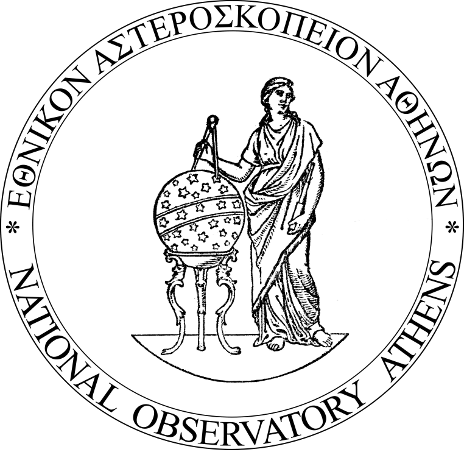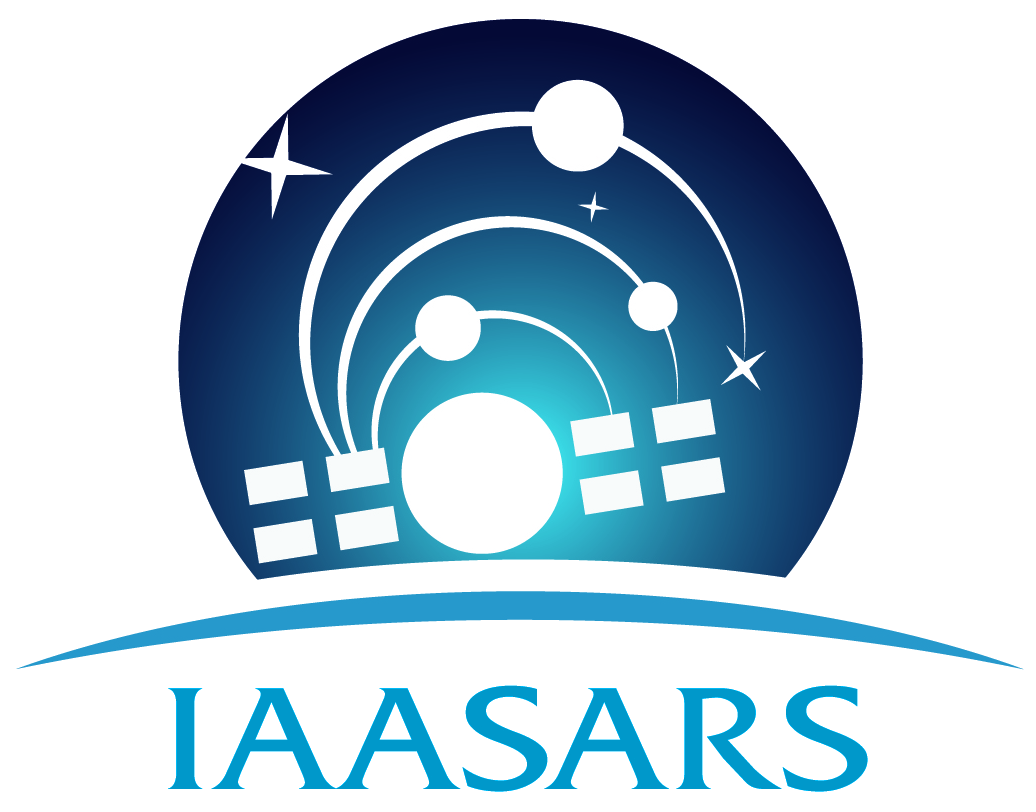About
The Space Research and Technology Group (SRTG) of IAASARS/NOA specializes in studies of planetary and interplanetary plasmas, geomagnetism and space magnetism, and space weather prediction. The main scientific objective of the group is the detailed investigation of interconnected space plasma physics phenomena at the Sun, the interplanetary space and the Earth and other planets.
Members of the Group have been participating in several ESA and NASA space missions under the Co-Investigator or Group Member status (e.g., Swarm, Solar Orbiter, Solar Parker Probe, Proba-3, Rosetta, Cluster, THEMIS, etc.), and have been involved in the planning of future space missions. Furthermore, the Group is participating in the calibration and validation activities of the instruments onboard space missions (i.e., ESA/Swarm), and is providing information on the scientific performance of ESA’s space science missions (SCI & HRE).
Our research activity involves:
- Development of original advanced algorithms for processing raw space measurements of particles and electromagnetic field as well as methodologies for data assimilation in order to study physical parameters related to space exploration, (i.e. survey, mapping and understanding of the near-Earth Space and our Solar System planets)
- Modelling and analysis software development for the implementation of space mission objectives.
- Theoretical studies and numerical simulations of basic plasma physical processes.
- Technology development for space instrumentation.
Strong scientific collaborations exist with the Physics Department at the University of Athens, the Research Center of Astronomy and Applied Mathematics at the Academy of Athens, the Physics Department at the University of Ioannina and a number of research institutes in Europe, USA and Japan.
Research Topics
Research topics include among others:
- Cosmic rays (CRs) of both galactic (GCRs) and solar (SCRs) origin.
- Large scale structures (Interplanetary Coronal Mass Ejections - ICMEs) their interaction with GCRs and the resulting Forbush decreases (FDs).
- Solar Energetic Particle (SEP) Events analysis and interpretation space born measurements. Analysis and interpretation of SCRs measurements resulting at Ground Level Enhancement (GLE) events.
- Exploring the connection chain of ICMEs, FDs and Geomagnetic effects/storms.
- Space borne and Ground-based Magnetometry
- Development of forecasting systems focused at Space Storms and Space Weather with emphasis on data driven models.
- Application of multivariate and machine learning approaches for the assessment of Space Weather conditions.
- Time Series Analysis and studies of Complex Systems
- Statistics on the scientific performance of ESA’s space science missions
Services
Solar Energetic Particle Advanced Warning System (SAWS-ASPECS tool)
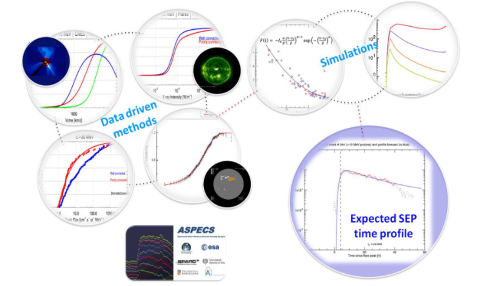
The Space Research & Technology Group leaded the development and operates the Solar particle radiation SAWS-ASPECS tool. This web-based tool collates and combines outputs from different modules providing forecasts of solar phenomena, solar proton event occurrence and solar proton flux and duration characteristics; tailored to the needs of different spacecraft and launch operators, as well as the aviation sector. The predictions start with the solar flare forecasting and continuously evolve through updates based on near-real time inputs (e.g., solar flare and coronal mass ejections data/characteristics) received by the system. User requirements include a derivation of energies and thresholds important for different user-groups and warning levels. In addition, for the first time the complete time profile of the SEP event at respective energies is provided in near real-time, utilizing both simulations and observations. The SAWS-ASPECS tool participates to the SEP scoreboard lead by the NASA/CCMC. The development of the SAWS-ASPECS tool has been supported through the ESA Contract No. 4000120480/NL/LF/hh "Solar Energetic Particle (SEP) Advanced Warning System (SAWS)".
FORSPEF Tool (FORecasting Solar Particle Events and Flares Tool)

The Space Research & Technology Group developed and operates the FORSPEF tool, that provides forecasting of solar eruptive events, such as solar flares with a projection to coronal mass ejections (CMEs) (occurrence and velocity) and the likelihood of occurrence of a solar energetic proton (SEP) event. The tool also provides nowcasting of SEP events based on actual solar flare and CME near real-time alerts, as well as SEP characteristics (peak flux, fluence, rise time, duration) per parent solar event. The forecasting scheme extends to 24 hours with a refresh rate of 3 hours while the respective warning time for the nowcasting scheme depends on the availability of the near real-time data and falls between 15-20 minutes. The FORSPEF tool participates to the SEP scoreboard lead by the NASA/CCMC. The development of the FORSPEF tool has been supported through the ESA Contract No. 4000109641/13/NL/AK "Improvement of Solar Particle Events and Flare Prediction".
SEPF Tool (Solar Energetic Proton Fluxes Tool)
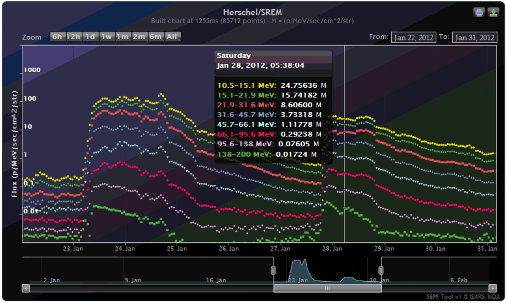
The Space Research and Technology Group developed and operated the Solar Energetic Proton Flux (SEPF) tool, which was a European space weather asset. The tool provided solar energetic proton fluxes at various locations in space using the count-rate measurements of the ESA Standard Radiation Environment Monitor (SREM) units on-board INTEGRAL, Herschel, Planck, and Rosetta spacecraft. The SEPF tool downloaded SREM data, calculated the differential proton fluxes and displayed derived results of SREM measurements. The tool was based on the application of a linear algorithm solver for the inverse problem of calculating fluxes from the SREM count-rate measurements. The inverse method was developed and validated by comparing results of selected number of past solar energetic particle events with measurements from other proton monitors. The development of the SEPF tool has been supported through the ESA Contract No. 21480/08/NL/NR “SREM Solar Particle Event Scientific Analysis”.
Science Archive Publication System (SAPS) tool

The Space Research and Technology Group developed, operates, and maintain the Science Archive Publication System (SAPS) tool. The SAPSproject is coordinated by ESA (European Space Agency) and its purpose is to provide information on the scientific performance of ESA's operating missions. The group provides metadata statistics for the evaluation of the scientific productivity of a space science mission and of how it evolves over time, as well as supporting decision-making regarding future science missions. The development of the SAPS tool has been supported through the ESA Contracts No. 4000120487/17/ES/JD “LPUB-SAPS ” and the ESA Contract No. 4000128429/19/ES/JD “TACTICIAN”.
Erasmus Experiment Archive (EEA) Dundas BI

The Space Research and Technology Group developed, updates, operates, and maintains the ESA Erasmus Experiment Archive (EEA) Dundas BI. The group through the ESA EEA Dundas BI platform, provides visualizations and queries of the ESA EEA database. The EEA consists by ESA funded or co-funded experiments covering a wide range of scientific areas, which were performed during missions and campaigns on/in various space platforms and microgravity ground-based facilities (Space Stations, Space Shuttle, Retrievable Capsules, Sounding Rockets, Parabolic Flights, Ground-based Facilities). The development of the EEA Dundas BI has been supported through the ESA Contract No. 4000128429/19/ES/JD“TACTICIAN”.
Facilities
The HellENIc GeoMagnetic Array (ENIGMA)
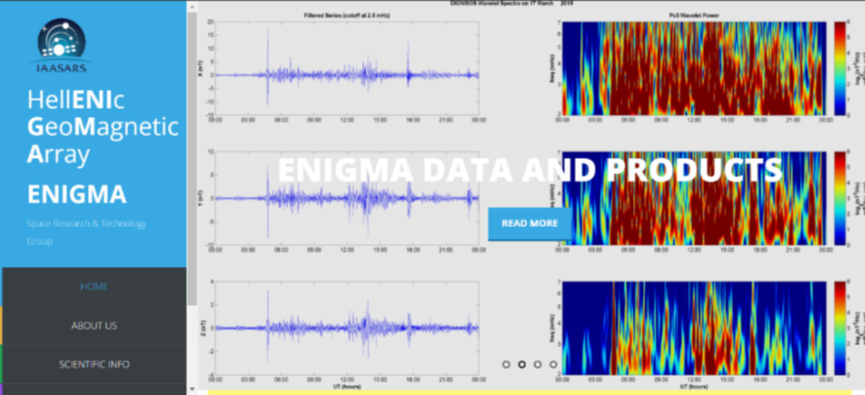
The Space Research & Technology Group operates the ENIGMA an array of 4 ground-based magnetometer stations in the areas of Trikala, Attiki, Lakonia and Lasithi that provides measurements for the study of geomagnetic pulsations, resulting from the solar wind - magnetosphere coupling and magnetosphere - ionosphere coupling physics. (for more details visit the ENIGMA website). ENIGMA, the first magnetometer station array ever operated in Greece, is part of SuperMAG, a worldwide collaboration of organizations and national agencies that currently operate more than 300 ground-based magnetometers. One of the ENIGMA main research objectives is the study of space weather effects on the ground, i.e., Geomagnetically Induced Currents (GIC).
R&D Projects
- The Influence of Solar Wind Structures on Energetic Particles in the Heliosphere Over a Wide Energy Range, NASA Living with a Star (LWS), 2020-2024
- QUASARE project: Quantification of Spectral and Angular Characteristics of Extreme Solar Eruptive Events, Academy of Finland, 2020-2024
- MEDIMNOS project: Modeling and Measuring Electrical Properties of Desert Dust Layers (MIS 5049929), co-financed by Greece and the European Union (European Social Fund- ESF), 2020-2022
- ETERNAL project: The Role Of Solar And Stellar Energetic Particles On (Exo)Planetary Habitability, International Space Science Institute (ISSI), International Team, 2019-2021
- ESA- SWUNMed project: Space Weather User Needs for the Mediterranean Region, European Space Angency/ESOC, 2019-2021.
- ESA- INTENS project: Characterisation of IoNospheric TurbulENce level by Swarm constellation, European Space Angency/ESRIN, 2019-2020.
- TRACER project: TRAcking interplanetary Coronal mass Ejections with foRbush decreases, National Observatory of Athens, 2018-2020.
- HEROIC project: High EneRgy sOlar pariCle events analysis, International Space Science Institute (ISSI) International Team, 2018-2021.
- ESA-ASPECS project: Advanced Solar Particle Events Casting Systems, European Space Agency/ESTEC, 2017-2022.
- ESA-AREMBES project: Athena Radiation Environment Models and X-Ray Background Effects Simulators, European Space Agency/ESTEC, 2016-2018.
- ESA-SAPS project: Design, Implementation and Maintenance of a Publication System for the ESAC Science Archives, European Space Agency/ESAC, 2013 - 2015.
- LPUB-SAPS project: Linking data and publications in ESA’s Science Archives Publications System, European Space Agency/ESAC, 2017 – 2022.
- TACTICIAN project: arTificiAl intelligenCe To lInk publiCations wIth observAtioNs, European Space Agency/ESAC, 2019 – 2023.
- ESA-FORSPEF project: FORecasting Solar Particle Events and Flares, European Space Agency, 2013-2014.
- ESAC-SAPS project: Design, Implementation and Maintenance of a Publication System for the ESAC Science Archives, European Space Agency, 2013 - 2015.
- HNSWRN Project: Hellenic National Space Weather Research Network. Hellenic Ministry of Education, Lifelong Learning and Religious Affairs, 2012-2015.
- SRREMs Project: Slot Region Radiation Environment Models, European Space Agency, 2011-2014.
- MAARBLE Project: Monitoring, Analyzing and Assessing Radiation Belt Loss and Energization, FP7 Collaborative project, Theme: "Space", European Commission, 2012-2014.
- ULFwave Project: Multi-Satellite, multi-instrument and ground based observations analysis and study of ULF wave phenomena and products. European Space Agency, 2011-2013.
- Space-data routers: a space communication overlay for efficient sharing of space-data. FP7 Cooperation Theme: "Space", European Commission, 2010-2012.
- SREM Extension - Solar Particle Event Scientific Analysis. European Space Agency, 2010-2011.
- National Network of Excellence in High-Performance Computing. Greek General Secretariat for Research and Technology, 2010-2011.
- Thermopolis 2009: A coordinated measurements campaign to support the Urban Heat Islands project. European Space Agency, EOEP (Earth Observation Envelope Programme), 2009-2010.
- EuroPlaNeT RI - European Planetology Network Research Infrastructure: An Integrated Infrastructure Initiative (I3), funded through FP7. European Commission, 2009-2012.
- Urban Heat Islands and Urban Thermography: A project on the integration and assimilation of spacecraft Earth Observation data and ground-based data into urban meteorological and climate modeling. European Space Agency, EOEP (Earth Observation Envelope Programme), 2008-2011.
- Hands-On Universe, Europe (EU-HOU): Bringing frontline interactive astronomy to the classroom. FP7 Lifelong Learning Programme, European Commission, 2008-2010.
- SREM - Solar Particle Event Scientific Analysis. European Space Agency, 2008-2010.
- Design and Implementation of the PICAM Detector Simulation Module for the BepiColombo Mission of the European Space Agency. Greek General Secretariat for Research and Technology, 2007-2009.
- Space Weather Prediction Using Nonlinear Techniques. Greek National Scholarships Foundation, 2007.
- Analysis and modeling of space measurements of the Earth's magnetic field for the estimation of GICs in Greece. Greek General Secretariat for Research and Technology, 2006-2008.
- The role of Solar wind and Earth's ionosphere in the development of Magnetic Storms in Geospace. Greek General Secretariat of Research and Technology, French-Greek bilateral research project, 2002 - 2004.
- ESPRIT 2003: Effects of Space Weather on Technology Infrastructure. Advanced Research Workshop, NATO, 2003.
- National Programme of Control Thermonuclear Fusion. Association EURATOM-Hellenic Republic, 2001 - .
- Interpretation of the Statistical Properties of the Observed Radiation Signatures from Solar Energetic Events. Greek General Secretariat of Research and Development, French-Greek bilateral research project, 2001-2002.
- STORMS 2000: Space Storms and Space Weather Hazards. Advanced Study Institute, NATO, 2000.
Publications
SRTG Publications of 2022
- Papaioannou, A., Kouloumvakos, A., Mishev, A., Vainio, R., Usoskin, I., Herbst, K., Rouillard, A.P., Anastasiadis, A., Gieseler, J., Wimmer-Schweingruber, R. and Kühl, P., 2022. The first ground-level enhancement of solar cycle 25 on 28 October 2021. Astronomy & Astrophysics Let., 660, p.L5.
- Mallios, S.A., Papaioannou, A., Herbst, K., Papangelis, G. and Hloupis, G., 2022. Study of the Ground Level Enhancements effect on atmospheric electric properties and mineral dust particle charging. Journal of Atmospheric and Solar-Terrestrial Physics, 233, p.105871.
- Papaioannou A., Vainio R., Raukunen O., Jiggens P., Aran A., Dierckxsens M., Mallios S.A., Paassilta M., Anastasiadis A., 2022. The Probabilistic Solar Particle Event foRecasting (PROSPER) Model, J. Space Weather & Space Clim., DOI:10.1051/swsc/2022019
- Dimitrakoudis S., Mann I. R., Balasis G., Papadimitriou C., Anastasiadis A., and Daglis I. A., 2022. On the interplay between solar wind parameters and ULF wave power as a function of geomagnetic activity at high- and mid-latitudes. Journal of Geophysical Research, 127, e2021JA029693, doi:10.1029/2021JA029693
- Belov, A., Shlyk, N., Abunina, M., Abunin, A. and Papaioannou, A., 2022. Estimating the Transit Speed and Time of Arrival of Interplanetary Coronal Mass Ejections Using CME and Solar Flare Data. Universe, 8(6), p.327.DOI: 10.3390/universe8010000, 2022
SRTG Publications of 2021
- Herbst, K., Papaioannou, A., Airapetian, V.S. and Atri, D., 2021. From Starspots to Stellar Coronal Mass Ejections—Revisiting Empirical Stellar Relations.The Astrophysical Journal, 907(2), p.89.
- Sasmal, S., Chowdhury, S., Kundu, S., Politis, D.Z., Potirakis, S.M., Balasis, G., Hayakawa, M. and Chakrabarti, S.K., 2021. Pre-seismic irregularities during the 2020 Samos (Greece) earthquake (M= 6.9) as investigated from multi-parameter approach by ground and space-based techniques.Atmosphere, 12(8), p.1059.
- Paouris, E., Čalogović, J., Dumbović, M., Mays, M.L., Vourlidas, A., Papaioannou, A., Anastasiadis, A. and Balasis, G., 2021. Propagating conditions and the time of icme arrival: a comparison of the effective acceleration model with enlil and dbem models.Solar Physics, 296(1), pp.1-16.
- Consolini, G., Tozzi, R., De Michelis, P., Coco, I., Giannattasio, F., Pezzopane, M., Marcucci, M.F. and Balasis, G., 2021. High-latitude polar pattern of ionospheric electron density: Scaling features and IMF dependence.Journal of Atmospheric and Solar-Terrestrial Physics, 217, p.105531.
- Manshour, P., Balasis, G., Consolini, G., Papadimitriou, C. and Paluš, M., 2021. Causality and information transfer between the solar wind and the magnetosphere–ionosphere system.Entropy, 23(4), p.390.
- Belov, A., Papaioannou, A., Abunina, M., Dumbovic, M., Richardson, I.G., Heber, B., Kuhl, P., Herbst, K., Anastasiadis, A., Vourlidas, A. and Eroshenko, E., 2021. On the Rigidity Spectrum of Cosmic-Ray Variations within Propagating Interplanetary Disturbances: Neutron Monitor and SOHO/EPHIN Observations at∼ 1–10 GV.The Astrophysical Journal, 908(1), p.5.
- Lavasa, E., Giannopoulos, G., Papaioannou, A., Anastasiadis, A., Daglis, I.A., Aran, A., Pacheco, D. and Sanahuja, B., 2021. Assessing the Predictability of Solar Energetic Particles with the use of Machine Learning techniques.Solar Physics, 296(7), pp.1-47.
- Paouris, E., Vourlidas, A., Papaioannou, A. and Anastasiadis, A., 2021. Assessing the Projection Correction of Coronal Mass Ejection Speeds on Time‐of‐Arrival Prediction Performance Using the Effective Acceleration Model.Space Weather, 19(2), p.e2020SW002617.
- Papadimitriou, C., Balasis, G., Boutsi, A.Z., Antonopoulou, A., Moutsiana, G., Daglis, I.A., Giannakis, O., De Michelis, P., Consolini, G., Gjerloev, J. and Trenchi, L., 2021. Swarm‐Derived Indices of Geomagnetic Activity.Journal of Geophysical Research: Space Physics, 126(11), p.e2021JA029394.
- McGranaghan, R.M., Camporeale, E., Georgoulis, M. and Anastasiadis, A., 2021. Space Weather research in the Digital Age and across the full data lifecycle: Introduction to the Topical Issue.Journal of Space Weather and Space Climate, 11, p.50.
- Katsavrias, C., Raptis, S., Daglis, I.A., Karlsson, T., Georgiou, M. and Balasis, G., 2021. On the generation of Pi2 pulsations due to plasma flow patterns around magnetosheath jets.Geophysical Research Letters, 48(15), p.e2021GL093611.
- Mallios, S.A., Papangelis, G., Hloupis, G., Papaioannou, A., Daskalopoulou, V. and Amiridis, V., 2021. Modeling of Spherical Dust Particle Charging due to Ion Attachment.Frontiers in Earth Science, 9, p.656.
- Contoyiannis, Y., Hanias, M.P., Papadopoulos, P., Stavrinides, S.G., Kampitakis, M., Potirakis, S.M. and Balasis, G., 2021. Tachyons and Solitons in Spontaneous Symmetry Breaking in the Frame of Field Theory.Symmetry, 13(8), p.1358.
- Zitis, P.I., Potirakis, S.M., Balasis, G. and Eftaxias, K., 2021. An Exploratory Study of Geospace Perturbations Using Financial Analysis Tools in the Context of Complex Systems.Geosciences, 11(6), p.239.
- Aminalragia-Giamini, S., Raptis, S., Anastasiadis, A., Tsigkanos, A., Sandberg, I., Papaioannou, A., Papadimitriou, C., Jiggens, P., Aran, A. and Daglis, I.A., 2021. Solar Energetic Particle Event occurrence prediction using Solar Flare Soft X-ray measurements and Machine Learning.Journal of Space Weather and Space Climate, 11, p.59.
- Balasis, G. and De Santis, A., 2021. Editorial of Special Issue “Detecting Geospace Perturbations Caused by Earth”.Geosciences, 11(12), p.496.
SRTG Publications of 2020
- Zouganelis, I., De Groof, A., Walsh, A.P., Williams, D.R., Müller, D., St Cyr, O.C., Auchère, F., Berghmans, D., Fludra, A., Horbury, T.S. and Howard, R.A., 2020. The Solar Orbiter Science Activity Plan-Translating solar and heliospheric physics questions into action.Astronomy & Astrophysics, 642, p.A3.
- Rouillard, A.P., Pinto, R.F., Vourlidas, A., De Groof, A., Thompson, W.T., Bemporad, A., Dolei, S., Indurain, M., Buchlin, E., Sasso, C. and Spadaro, D., 2020. Models and data analysis tools for the Solar Orbiter mission.Astronomy & Astrophysics, 642, p.A2.
- Papaioannou, A., Belov, A., Abunina, M., Eroshenko, E., Abunin, A., Anastasiadis, A., Patsourakos, S. and Mavromichalaki, H., 2020. Interplanetary coronal mass ejections as the driver of non-recurrent Forbush decreases.The Astrophysical Journal, 890(2), p.101.
- Freiherr von Forstner, J.L., Guo, J., Wimmer‐Schweingruber, R.F., Dumbović, M., Janvier, M., Démoulin, P., Veronig, A., Temmer, M., Papaioannou, A., Dasso, S. and Hassler, D.M., 2020. Comparing the Properties of ICME‐Induced Forbush Decreases at Earth and Mars.Journal of Geophysical Research: Space Physics, 125(3), p.e2019JA027662
- Aminalragia-Giamini, S., Jiggens, P., Anastasiadis, A., Sandberg, I., Aran, A., Vainio, R., Papadimitriou, C., Papaioannou, A., Tsigkanos, A., Paouris, E. and Vasalos, G., 2020. Prediction of Solar Proton Event Fluence spectra from their Peak flux spectra.Journal of Space Weather and Space Climate, 10, p.1.
- Kouloumvakos, A., Rouillard, A.P., Share, G.H., Plotnikov, I., Murphy, R., Papaioannou, A. and Wu, Y., 2020. Evidence for a Coronal Shock Wave Origin for Relativistic Protons Producing Solar Gamma-Rays and Observed by Neutron Monitors at Earth.The Astrophysical Journal, 893(1), p.76.
- De Michelis, P., Pignalberi, A., Consolini, G., Coco, I., Tozzi, R., Pezzopane, M., Giannattasio, F. and Balasis, G., 2020. On the 2015 St. Patrick's storm turbulent state of the ionosphere: Hints from the Swarm mission.Journal of Geophysical Research: Space Physics, 125(8), p.e2020JA027934.
- Papadimitriou, C., Balasis, G., Boutsi, A.Z., Daglis, I.A., Giannakis, O., Anastasiadis, A., Michelis, P.D. and Consolini, G., 2020. Dynamical Complexity of the 2015 St. Patrick’s Day Magnetic Storm at Swarm Altitudes Using Entropy Measures.Entropy, 22(5), p.574.
- Balasis, G., Papadimitriou, C., Boutsi, A.Z., Daglis, I.A., Giannakis, O., Anastasiadis, A., De Michelis, P. and Consolini, G., 2020. Dynamical complexity in Swarm electron density time series using Block entropy.EPL (Europhysics Letters), 131(6), p.69001
SRTG Publications of 2019
- Anastasiadis, A., Lario, D., Papaioannou, A., Kouloumvakos, A. and Vourlidas, A., 2019. Solar energetic particles in the inner heliosphere: status and open questions.Philosophical Transactions of the Royal Society A, 377(2148), p.20180100.
- Herbst, K., Papaioannou, A., Banjac, S. and Heber, B., 2019. From solar to stellar flare characteristics-On a new peak size distribution for G-, K-, and M-dwarf star flares.Astronomy & Astrophysics, 621, p.A67.
- Vlahos, L., Anastasiadis, A., Papaioannou, A., Kouloumvakos, A. and Isliker, H., 2019. Sources of solar energetic particles.Philosophical Transactions of the Royal Society A, 377(2148), p.20180095.
- Donner, R.V., Balasis, G., Stolbova, V., Georgiou, M., Wiedermann, M. and Kurths, J., 2019. Recurrence‐based quantification of dynamical complexity in the Earth's magnetosphere at geospace storm timescales.Journal of Geophysical Research: Space Physics, 124(1), pp.90-108.
- Papaioannou, A., Belov, A., Abunina, M., Guo, J., Anastasiadis, A., Wimmer-Schweingruber, R.F., Eroshenko, E., Melkumyan, A., Abunin, A., Heber, B. and Herbst, K., 2019. A catalogue of Forbush decreases recorded on the surface of Mars from 2012 until 2016: comparison with terrestrial FDs.Solar Physics, 294(6), pp.1-39.
- Potirakis, S.M., Schekotov, A., Contoyiannis, Y., Balasis, G., Koulouras, G.E., Melis, N.S., Boutsi, A.Z., Hayakawa, M., Eftaxias, K. and Nomicos, C., 2019. On possible electromagnetic precursors to a significant earthquake (Mw= 6.3) occurred in Lesvos (Greece) on 12 June 2017.Entropy, 21(3), p.241.
- Balasis, G., Papadimitriou, C. and Boutsi, A.Z., 2019. Ionospheric response to solar and interplanetary disturbances: a Swarm perspective.Philosophical Transactions of the Royal Society A, 377(2148), p.20180098.
- Balasis, G., Aminalragia-Giamini, S., Papadimitriou, C., Daglis, I.A., Anastasiadis, A. and Haagmans, R., 2019. A machine learning approach for automated ULF wave recognition.Journal of Space Weather and Space Climate, 9, p.A13.
SRTG Publications of 2018
- Belov, A., Eroshenko, E., Yanke, V., Oleneva, V., Abunin, A., Abunina, M., Papaioannou, A. and Mavromichalaki, H., 2018. The global survey method applied to ground-level cosmic ray measurements.Solar Physics, 293(4), pp.1-23.
- Guo, J., Lillis, R., Wimmer-Schweingruber, R.F., Zeitlin, C., Simonson, P., Rahmati, A., Posner, A., Papaioannou, A., Lundt, N., Lee, C.O. and Larson, D., 2018. Measurements of Forbush decreases at Mars: Both by MSL on ground and by MAVEN in orbit. Astronomy & Astrophysics, 611, p.A79.
- Pakhotin, I.P., Mann, I.R., Lysak, R.L., Knudsen, D.J., Gjerloev, J.W., Rae, I.J., Forsyth, C., Murphy, K.R., Miles, D.M., Ozeke, L.G. and Balasis, G., 2018. Diagnosing the role of Alfvén waves in magnetosphere‐ionosphere coupling: Swarm observations of large amplitude nonstationary magnetic perturbations during an interval of northward IMF. Journal of Geophysical Research: Space Physics,123(1), pp.326-340.
- Runge, J., Balasis, G., Daglis, I.A., Papadimitriou, C. and Donner, R.V., 2018. Common solar wind drivers behind magnetic storm–magnetospheric substorm dependency.Scientific reports, 8(1), pp.1-10
- Georgiou, M., Daglis, I.A., Rae, I.J., Zesta, E., Sibeck, D.G., Mann, I.R., Balasis, G. and Tsinganos, K., 2018. Ultralow frequency waves as an intermediary for solar wind energy input into the radiation belts.Journal of Geophysical Research: Space Physics, 123(12), pp.10-090.
- Papaioannou, A., Anastasiadis, A., Sandberg, I. and Jiggens, P., 2018. Nowcasting of Solar Energetic Particle Events using near real-time Coronal Mass Ejection characteristics in the framework of the FORSPEF tool.Journal of Space Weather and Space Climate, 8, p.A37
- Paassilta, M., Papaioannou, A., Dresing, N., Vainio, R., Valtonen, E. and Heber, B., 2018. Catalogue of >55 MeV Wide-longitude Solar Proton Events Observed by SOHO, ACE, and the STEREOs at ≈ 1 AU During 2009–2016.Solar Physics, 293(4), pp.1-53.
- Donner, R.V., Stolbova, V., Balasis, G., Donges, J.F., Georgiou, M., Potirakis, S.M. and Kurths, J., 2018. Temporal organization of magnetospheric fluctuations unveiled by recurrence patterns in the Dst index.Chaos: An Interdisciplinary Journal of Nonlinear Science, 28(8), p.085716.
- Papaioannou, A., Anastasiadis, A., Kouloumvakos, A., Paassilta, M., Vainio, R., Valtonen, E., Belov, A., Eroshenko, E., Abunina, M. and Abunin, A., 2018. Nowcasting solar energetic particle events using principal component analysis.Solar Physics, 293(7), pp.1-23.
- Balasis, G., Daglis, I.A., Contoyiannis, Y., Potirakis, S.M., Papadimitriou, C., Melis, N.S., GIannakis, O., Papaioannou, A., Anastasiadis, A. and Kontoes, C., 2018. Observation of intermittency‐induced critical dynamics in geomagnetic field time series prior to the intense magnetic storms of March, June, and December 2015.Journal of Geophysical Research: Space Physics, 123(6), pp.4594-4613
- Papadimitriou, C., Balasis, G., Daglis, I.A. and Giannakis, O., 2018, March. An initial ULF wave index derived from 2 years of Swarm observations. InAnnales Geophysicae(Vol. 36, No. 2, pp. 287-299). Copernicus GmbH.
- Georgoulis, M.K., Papaioannou, A., Sandberg, I., Anastasiadis, A., Daglis, I.A., Rodríguez-Gasén, R., Aran, A., Sanahuja, B. and Nieminen, P., 2018. Analysis and interpretation of inner-heliospheric SEP events with the ESA Standard Radiation Environment Monitor (SREM) onboard the INTEGRAL and Rosetta Missions.Journal of Space Weather and Space Climate, 8, p.A40.
Research Personnel
Researchers

PhD/Graduate Students
Research Staff on contract

Christos Katsavrias
POSTDOCTORAL RESEARCHER
